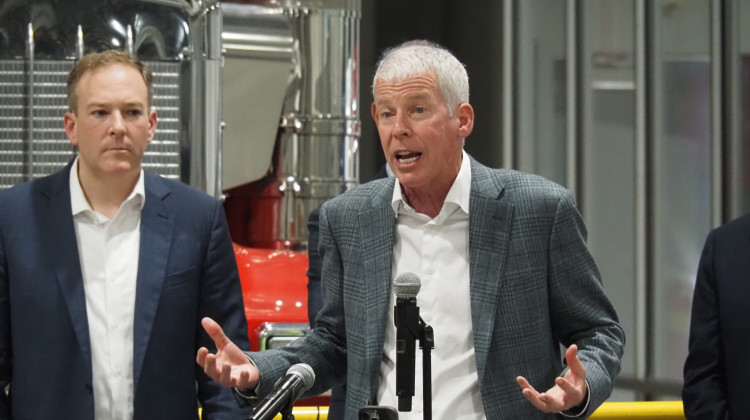By Becca Costello & Barbara Brosher

Aluminum cans ready to be filled at an Indiana craft brewery. (Photo: Barbara Brosher,WFIU/WTIU)
New tariffs on imported steel and aluminum are set to take effect Friday, and experts say Indiana will see both benefits and costs.
As NPR reports, President Trump ordered the 25 percent tariff on imported steel and 10 percent levy on imported aluminum from every country except Canada and Mexico.
Indiana is the largest steel-producing state in the nation, and those producers have been losing out to foreign competitors in recent years. Hoosier steel producers will benefit from the tariffs.
But Indiana’s manufacturing industry will have to adjust, either by paying the extra cost for foreign suppliers or switching providers.
Keith Belton is the Director of the Manufacturing Initiative at Indiana University’s School of Public and Environmental Affairs. He takes us through which Hoosiers will benefit from the tariffs, and which Hoosiers could lose out.
How will the tariffs impact producers and manufacturers?
The tariffs will benefit producers of steel and aluminum in Indiana. And they will harm downstream consumers of these products, which include a lot of manufactures.
Indiana is actually the largest steel producing state in the nation, but it’s also the most manufacturing-intensive state in the nation. And so Indiana will see both the benefits and costs from this action.
I think it’s important to know the benefits are extremely concentrated on a few producers because there aren’t that many steel producers. But the costs are spread out very diffusely across lots of different manufacturers and downstream consumers.
And so the price of a car, for example, because it has steel and aluminum in it, could be expected to rise by as much as 1 percent as a result of these tariffs. And the price of say a can of soup could be expected to rise less than a penny.
It will take a little while before it gets to consumers. But I’m not sure consumers are going to notice very much. Prices will go up, but as a percentage of the product it could be a very small price increase, depending how much steel and aluminum is in the product.
So that’s the kind of cost impact we’re seeing. But, there’s lots of people buying cans of soup, there’s lots of people buying cars. Whereas producers, if these tariffs weren’t put in place, could be decimated economically.
We’ve seen the aluminum and steel industries affected very adversely in this country over the past several years. And if this action isn’t taken, 25,000 steel workers who work in Indiana, their jobs could be at risk.
Will the tariffs have a larger impact on smaller manufacturing businesses?
I think it depends on various factors. Some of the largest companies that buy a lot of steel and aluminum have longer term contracts that set the price in place, so it might be a while before they see a price increase. And then they would have to worry about whether they would pass it on to their consumers or not.
Smaller companies usually don’t have long term contracts in place, so they tend to feel the effects sooner. But the degree of whether small or large are harmed more or less I think is a case by case determination.
How quickly will companies start to feel the impact?
For publicly traded companies we saw, when the announcement was made, immediate impact on stock price. The president announced these tariffs on March 8. They’re going into effect on March 23. And I think we will see fairly quickly producers make decisions about whether they want to raise their prices. And, if so, by how much and to whom. And that will be passed down the value chain.
I would say that you will see price increases from producers to their customers pretty immediately after March 23, if not already in anticipation of March 23. And then the impacts on the downstream industries to occur over the span of weeks to months.
Why did the Trump administration decide to impose these new tariffs?
In recent years the steel industry and aluminum industry have complained that there is global overcapacity in those product lines, meaning that world is producing more steel and aluminum than the world can really consume. And what that means is it brings prices down because of supply and demand and makes it very difficult for steel and aluminum producers to remain profitable and stay in business.
Now that’s especially a problem in the United States, where we have seen a very large increase in imports of steel and aluminum products in recent decades and in recent years. And the imports that are coming into the country and certain steel and aluminum products are much cheaper than what it costs to produce and make them in the United States.
And so to address this overcapacity problem, President Trump when he first came into office asked the department of commerce to undertake an investigation under Section 232 of the 1962 trade law, which allows the administration to determine if whether for national security reasons there might need to be tariffs or quotas on imports of certain products.
In this case the department of commerce took six months undertake their analysis. They did an investigation on certain aluminum products, they did an investigation on certain steel products, and their conclusion was the same. The phraseology in the law is that these imports threaten to impair the security of the United States. The administration used a very broad definition of national security to include not only defense of the United States, but also the ability of the United States to maintain critical infrastructure and the health of certain industrial sectors in the economy that were important to the country.
And so they made a determination that this does threaten to impair the national security of the United States and they recommended various tariffs or quotas to the President.
The president announced on March 8 that he decided across the board tariffs, 25 percent on certain steel products, and 10 percent on certain aluminum products, with an exemption for imports from Canada and Mexico. The president left open the possibility that additional countries could get exemptions or that certain kinds of steel products could get exclusions.
There’s no sunset date on these tariffs, so they go into effect until the administration decides to remove them.
What are the long-term implications for Indiana producers?
I think it means more certainty for producers in Indiana. So, for example, Indiana is the largest steel producing state in the nation. And what that means is integrated steel mills, which are the largest kind of steel mills, there are approximately nine of them in the United States and five of them are in Indiana.
Those steel mills will have more certainty now. They will either be able to increase their market share and/or raise prices and they will be able to plan for the future to a greater degree than before these tariffs were imposed.
Those companies will benefit, their workers will benefit, they’ll be at less risk of losing their jobs and those communities that really depend on those steel mills will see an economic plus.
There aren’t many aluminum smelters in the United States, and one of the largest ones was closed down in Evansville in 2016. They’re going to reopen three production lines by the second quarter of 2018. That announcement was made perhaps in anticipation of this action, but it was made before the President made the formal announcement.
So those towns and areas will benefit from these tariffs as long as they’re in place.
What can we expect in the near future?
The big question is how are other nations going to respond? And so the other nations have short term options and they have longer term options.
The long term option is they can bring a case to the WTO against the United States arguing the U.S. action and these tariffs go against WTO rules. That’s a long term strategy because it normally takes years … and there’s no guarantee that if another nation does that they will win the case. But if they do win the case, it would be possibly the biggest decision against the United States since we’ve been a part of the WTO and possibly a $10 billion hit to the U.S. How that works, though, is they would impose tariffs of their own against U.S. products, not necessarily on steel and aluminum products, that are coming into their country. But again, that’s a long-term issue and it will take years to resolve.
In the short run what we see is a lot of countries and regions seeking to get additional exemptions and exclusions. The president exempted Canada and Mexico. The European Union has expressed interest in getting an exemption as well, and other countries are probably looking for the same thing.
You can also get exclusions, so if there are particular steel products that are affected and there is no domestic producer, companies could get an exclusion for their product.
One of the other short run possibilities, which is probably the most problematic, is if other countries start using national security as a reason to impose their own tariffs on products from the United States entering those countries.
 DONATE
DONATE





 View More Articles
View More Articles



 Support WFYI. We can't do it without you.
Support WFYI. We can't do it without you.